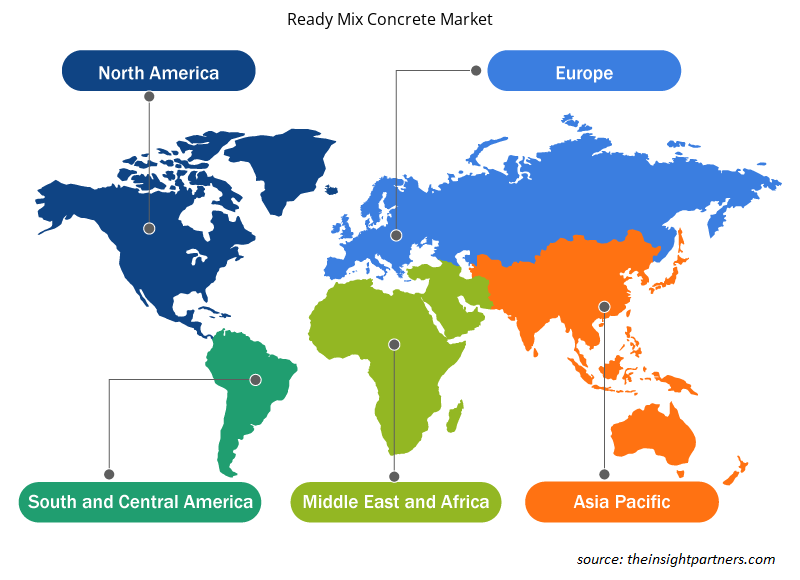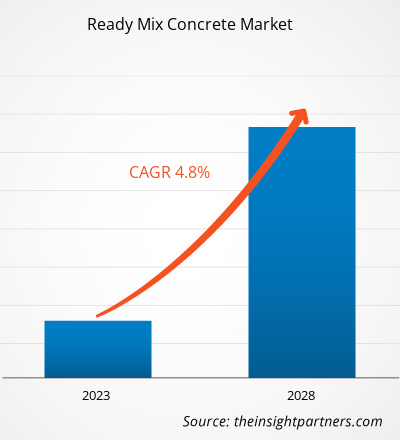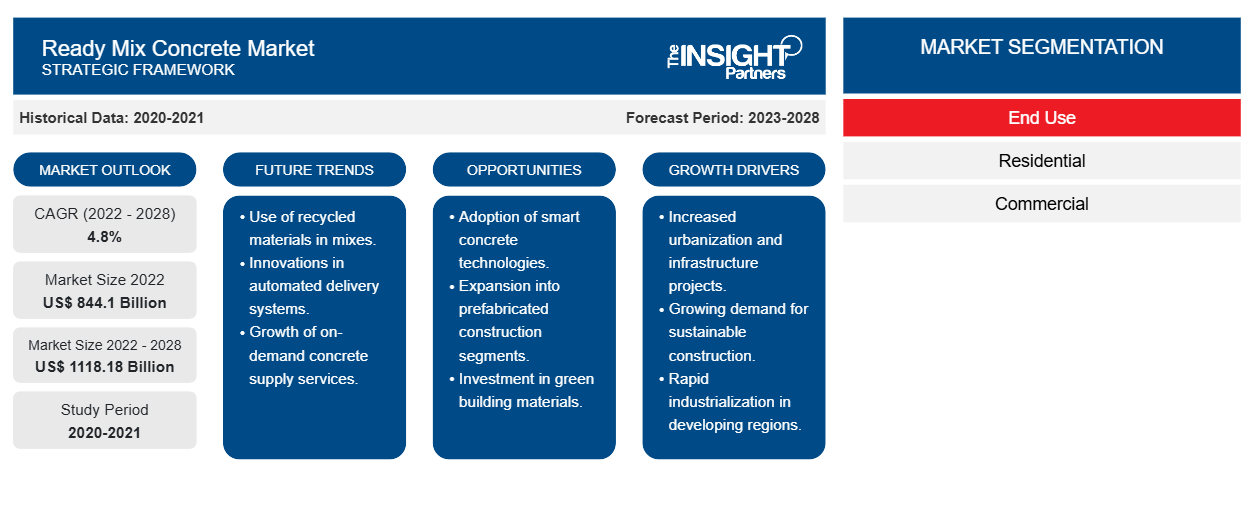Se espera que el tamaño del mercado de hormigón premezclado crezca de US$ 844,10 mil millones en 2022 a US$ 1,118,18 mil millones en 2028; se estima que crecerá a una CAGR del 4,8% entre 2022 y 2028.
El hormigón premezclado se fabrica en una planta de hormigón según cada requisito específico en el lugar de trabajo. El hormigón premezclado de tránsito, el hormigón premezclado por contracción y el hormigón premezclado central son algunos de los tipos de hormigón premezclado más utilizados. El hormigón premezclado se mezcla en un entorno controlado y se puede utilizar para una variedad de proyectos. El hormigón premezclado es sostenible y tiene una gran durabilidad, lo que genera una gran demanda en diferentes aplicaciones.
En 2021, Asia Pacífico tuvo la mayor participación en los ingresos del mercado mundial de hormigón premezclado . La región se ha destacado como uno de los mercados más importantes para la utilización de hormigón premezclado debido al aumento de las actividades de construcción. Se prevé que el creciente número de usos del hormigón premezclado en numerosos sectores residenciales y no residenciales siga aumentando la demanda de hormigón premezclado en Asia Pacífico. Además, las iniciativas y políticas gubernamentales como Make-in-India fomentan la instalación de diferentes plantas de fabricación en la India.
Personalice este informe según sus necesidades
Obtendrá personalización en cualquier informe, sin cargo, incluidas partes de este informe o análisis a nivel de país, paquete de datos de Excel, así como también grandes ofertas y descuentos para empresas emergentes y universidades.
-
Obtenga las principales tendencias clave del mercado de este informe.Esta muestra GRATUITA incluirá análisis de datos, desde tendencias del mercado hasta estimaciones y pronósticos.
Impacto de la pandemia de COVID-19 en el mercado del hormigón premezclado
Antes de la pandemia de COVID-19, el mercado del hormigón premezclado estaba impulsado principalmente por su creciente uso en aplicaciones residenciales y comerciales. Sin embargo, en 2020, varias industrias tuvieron que ralentizar sus operaciones debido a las interrupciones en las cadenas de valor causadas por el cierre de las fronteras nacionales e internacionales a raíz de la pandemia de COVID-19. La industria de la construcción se vio muy afectada, lo que afectó negativamente al consumo de hormigón premezclado en diferentes regiones. Además, las interrupciones de la cadena de suministro detuvieron la fabricación y distribución de materiales de construcción. Los constructores experimentaron un aumento de los costos y retrasos en las materias primas importadas y los materiales de construcción externos debido a que muchas fábricas permanecieron cerradas durante períodos prolongados. La construcción de edificios fue casi insignificante en Europa debido a la escasez de trabajadores y la interrupción de la cadena de suministro de materias primas.
Sin embargo, en 2021, varios países comenzaron a relajar las restricciones. El mercado mundial comenzó a recuperarse de las pérdidas. A los fabricantes se les permitió operar a plena capacidad, lo que los ayudó a superar la brecha de suministro. En Europa, varias industrias, incluida la industria de la construcción, han vuelto a la normalidad y las limitaciones de suministro que las afectan se están resolviendo gradualmente. Se espera que la creciente demanda de hormigón premezclado en diversas aplicaciones industriales y las crecientes iniciativas de los organismos gubernamentales para combatir el COVID-19 promuevan sustancialmente el mercado del hormigón premezclado a nivel mundial.
Perspectivas del mercado
Aumento de proyectos de construcción comerciales y residenciales
El hormigón premezclado se utiliza en casi todos los proyectos de construcción debido a sus ventajas, como la reducción del tiempo de construcción, el bajo coste de mantenimiento y la versatilidad. El rápido crecimiento de la población ha obligado a los organismos gubernamentales a promover reformas en la planificación urbana. Por ejemplo, la población de Dubái aumentó en 0,1 millones entre 2020 y 2022, y el gobierno prevé que en 2040 la población sea de 5,8 millones. La estabilidad económica del país, la mejor conectividad, el bajo coste de la energía y la estrategia de diversificación del gobierno son los factores responsables de impulsar a los inversores y clientes a invertir en propiedades residenciales y comerciales. Según la Unión Europea, el Fondo Europeo de Desarrollo Regional (FEDER) ha destinado el 8% a reforzar el desarrollo urbano sostenible y apoyar la dimensión urbana de la política de cohesión. La estrategia de la ola de renovación de la Comisión Europea incluye iniciativas de vivienda asequible y apunta a los edificios ecológicos. Todos estos factores están incidiendo positivamente en el crecimiento del mercado del hormigón premezclado.ERDF) allocated 8% to strengthen sustainable urban development and support the cohesion policy's urban dimension. The European Commission’s renovation wave strategy involves affordable housing initiatives and aims for green buildings. All these factors are positively impacting the ready mix concrete market growth.
Perspectivas basadas en el uso final
Según el uso final, el mercado mundial del hormigón premezclado se segmenta en residencial, comercial y otros. La cuota de mercado del hormigón premezclado para el segmento residencial fue la mayor en 2021. El sector residencial incluye viviendas privadas, apartamentos y edificios. Las inversiones y actividades de desarrollo en el sector de la infraestructura residencial se pueden atribuir al aumento de la población y la urbanización. Además, las políticas gubernamentales favorables en muchos países han llevado al establecimiento de edificios residenciales y unidades de fabricación de hormigón premezclado, lo que se prevé que aumente la demanda de hormigón premezclado del sector residencial.
Entre los actores que operan en el mercado global del hormigón premezclado se encuentran ACC Limited; Vicat SA; LafargeHolcim; Buzzi Unicem SpA; BARNEY AND DICKENSON INC.; RW Sidley, Inc.; CEMEX SAB DE CV; HEIDELBERGCEMENT AG; ULTRATECH CEMENT LTD.; y CROWN CEMENT PLC. Los actores que operan en el mercado del hormigón premezclado se centran en proporcionar productos de alta calidad para satisfacer las demandas de los clientes. También se centran en estrategias como inversiones en actividades de investigación y desarrollo y fusiones y adquisiciones.
Informe Destacado
- Tendencias progresivas en la industria del hormigón premezclado para ayudar a los actores a desarrollar estrategias efectivas a largo plazo
- Estrategias de crecimiento empresarial adoptadas por los mercados desarrollados y en desarrollo
- Análisis cuantitativo del mercado de 2020 a 2028
- Estimación de la demanda mundial de hormigón premezclado
- Análisis de las cinco fuerzas de Porter para ilustrar la eficacia de los compradores y proveedores que operan en la industria
- Avances recientes para comprender el escenario competitivo del mercado
- Tendencias y perspectivas del mercado, así como factores que impulsan y restringen el crecimiento del mercado del hormigón premezclado
- Asistencia en el proceso de toma de decisiones destacando las estrategias de mercado que sustentan el interés comercial y conducen al crecimiento del mercado.
- El tamaño del mercado de hormigón premezclado en varios nodos
- Descripción detallada y segmentación del mercado, así como la dinámica de la industria del hormigón premezclado
- El tamaño del mercado de hormigón premezclado en varias regiones con oportunidades de crecimiento prometedoras
El mercado mundial de hormigón premezclado está segmentado por uso final en residencial, comercial y otros.
Perspectivas regionales del mercado del hormigón premezclado
Los analistas de Insight Partners explicaron en detalle las tendencias y los factores regionales que influyen en el mercado del hormigón premezclado durante el período de pronóstico. Esta sección también analiza los segmentos y la geografía del mercado del hormigón premezclado en América del Norte, Europa, Asia Pacífico, Oriente Medio y África, y América del Sur y Central.

- Obtenga datos regionales específicos para el mercado de hormigón premezclado
Alcance del informe de mercado de hormigón premezclado
| Atributo del informe | Detalles |
|---|---|
| Tamaño del mercado en 2022 | US$ 844,1 mil millones |
| Tamaño del mercado en 2028 | US$ 1118,18 mil millones |
| CAGR global (2022-2028) | 4,8% |
| Datos históricos | 2020-2021 |
| Período de pronóstico | 2023-2028 |
| Segmentos cubiertos |
Por uso final
|
| Regiones y países cubiertos |
América del norte
|
| Líderes del mercado y perfiles de empresas clave |
|
Densidad de actores del mercado: comprensión de su impacto en la dinámica empresarial
El mercado del hormigón premezclado está creciendo rápidamente, impulsado por la creciente demanda de los usuarios finales debido a factores como la evolución de las preferencias de los consumidores, los avances tecnológicos y una mayor conciencia de los beneficios del producto. A medida que aumenta la demanda, las empresas amplían sus ofertas, innovan para satisfacer las necesidades de los consumidores y aprovechan las tendencias emergentes, lo que impulsa aún más el crecimiento del mercado.
La densidad de actores del mercado se refiere a la distribución de las empresas o firmas que operan dentro de un mercado o industria en particular. Indica cuántos competidores (actores del mercado) están presentes en un espacio de mercado determinado en relación con su tamaño o valor total de mercado.
Las principales empresas que operan en el mercado del hormigón premezclado son:
- ACC limitada
- Vicat SA
- LafargeHolcim
- Buzzi Unicem SpA
- BARNEY Y DICKENSON INC.
Descargo de responsabilidad : Las empresas enumeradas anteriormente no están clasificadas en ningún orden particular.

- Obtenga una descripción general de los principales actores clave del mercado de hormigón premezclado
Perfiles de empresas
- ACC limitada
- Vicat SA
- LafargeHolcim
- Buzzi Unicem SpA
- BARNEY Y DICKENSON INC.
- R.W.Sidley, Inc.
- CEMEX SAB DE CV
- CEMENTOS HEIDELBERG AG
- CEMENTO ULTRATECH LTD.
- CEMENTOS CORONA PLC.
- Análisis histórico (2 años), año base, pronóstico (7 años) con CAGR
- Análisis PEST y FODA
- Tamaño del mercado, valor/volumen: global, regional y nacional
- Industria y panorama competitivo
- Conjunto de datos de Excel
Informes recientes
Testimonios
Razón para comprar
- Toma de decisiones informada
- Comprensión de la dinámica del mercado
- Análisis competitivo
- Información sobre clientes
- Pronósticos del mercado
- Mitigación de riesgos
- Planificación estratégica
- Justificación de la inversión
- Identificación de mercados emergentes
- Mejora de las estrategias de marketing
- Impulso de la eficiencia operativa
- Alineación con las tendencias regulatorias























 Obtenga una muestra gratuita para - Mercado de hormigón premezclado
Obtenga una muestra gratuita para - Mercado de hormigón premezclado